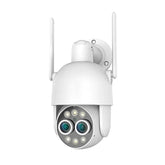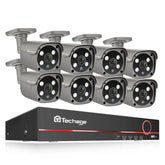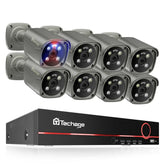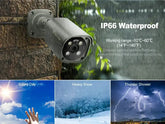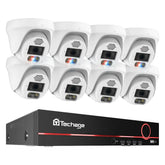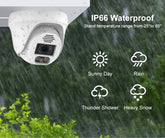What's the Differences Between Wired and Wireless IP Cameras
IP cameras have transformed the field of video surveillance, offering advanced features and enhanced security. When considering IP cameras, one crucial decision to make is whether to opt for wired or wireless cameras. Both options have their distinct advantages and considerations. In this blog post, we will explore the differences between wired and wireless IP cameras and discuss the circumstances in which each type is the most suitable choice.
What is the main differences between Wired and Wireless IP Cameras?
Connectivity:
The most obvious difference between wired and wireless IP cameras is the method of connectivity. Wired IP cameras require a physical Ethernet cable connection to the network switch or router. On the other hand, wireless IP cameras utilize Wi-Fi or other wireless technologies to connect to the network.
Installation and Flexibility:
Wired IP cameras often require professional installation due to the need for running cables. They are best suited for fixed locations where cabling is feasible, such as mounting on walls or ceilings. Wireless IP cameras, on the other hand, offer greater flexibility in terms of installation. They can be easily placed and moved around within the Wi-Fi network coverage area, allowing for more adaptable surveillance options.
Reliability and Stability:
Wired IP cameras generally provide a more stable and reliable connection since they are not subject to interference from other wireless devices or signal degradation due to distance. They are less susceptible to signal loss or interruptions, ensuring consistent video streaming and recording. In contrast, wireless IP cameras may experience occasional signal drops or interference, depending on the quality of the Wi-Fi network and environmental factors.
Bandwidth and Video Quality:
Wired IP cameras typically offer higher bandwidth capabilities, allowing for the transmission of uncompressed or higher resolution video streams. This results in superior video quality and clarity. Wireless IP cameras, while capable of transmitting high-quality video, may be subject to bandwidth limitations and compression algorithms, which can affect the overall video resolution and image quality.
Range and Coverage:
Wired IP cameras are not limited by the range of Wi-Fi signals and can be placed at longer distances from the network switch or router. This makes them suitable for large areas or outdoor surveillance where Wi-Fi coverage may be limited. Wireless IP cameras have a limited range dictated by the strength and reach of the Wi-Fi network. Signal extenders or repeaters can be used to expand the coverage area, but it may still be challenging to achieve reliable connectivity in certain scenarios.
Security:
Wired IP cameras are generally considered more secure as they operate within a closed, physical network. This makes them less vulnerable to unauthorized access or hacking attempts compared to wireless IP cameras, which are susceptible to Wi-Fi network vulnerabilities. However, proper security measures, such as strong Wi-Fi encryption and password protection, can mitigate the risks associated with wireless IP cameras.
What about the specific scene application for Wired and Wireless IP Cameras?
For Wired IP Cameras
Wired IP cameras are connected to the network using physical cables, typically Ethernet cables. Here are some key characteristics and scenarios where wired IP cameras excel:
1.Stability and Reliability:
Wired IP cameras offer a higher level of stability and reliability compared to their wireless counterparts. Since they rely on physical connections, they are not susceptible to interference from other wireless devices or signal degradation due to distance. This makes wired cameras ideal for critical surveillance applications where uninterrupted connectivity is essential.
2.Power Supply:
Wired IP cameras usually require a separate power source, such as a power outlet or Power over Ethernet (PoE) switch. PoE technology eliminates the need for additional power cables by providing both power and data transmission through a single Ethernet cable. Wired cameras are suitable when power availability is not a concern or when infrastructure is already in place to support them.
3.High-Bandwidth Applications:
Wired IP cameras can handle high-bandwidth applications, such as high-resolution video streaming or multiple camera installations. With a wired connection, there is typically more available bandwidth, ensuring smooth and reliable transmission of data. This is advantageous in scenarios where detailed video quality and real-time monitoring are crucial.
4.Fixed Installations:
Wired IP cameras are commonly used in fixed installations where the camera locations are predetermined and do not require frequent movement or relocation. These cameras are often hardwired into the infrastructure, making them a preferred choice for long-term surveillance setups in indoor or outdoor environments.
For Wireless IP Cameras
Wireless IP cameras, as the name suggests, communicate with the network using wireless technology, such as Wi-Fi. Here are some key characteristics and scenarios where wireless IP cameras are advantageous:
1.Flexibility and Easy Installation:
Wireless IP cameras offer unparalleled flexibility and ease of installation. They can be installed in locations where running physical cables is impractical or costly, such as historic buildings, temporary sites, or areas with limited access to power outlets. Wireless cameras eliminate the need for extensive wiring, simplifying the installation process.
2.Mobility and Remote Monitoring:
Wireless IP cameras provide mobility and allow for remote monitoring. They can be easily moved or repositioned within the Wi-Fi range, providing flexibility in adapting to changing surveillance needs. Wireless cameras are ideal for temporary monitoring requirements or situations where the camera needs to be relocated frequently.
3.Cost-Effectiveness:
Wireless IP cameras can be cost-effective in certain scenarios. They eliminate the need for extensive cabling, conduits, and associated labor costs, making them a viable option for budget-conscious installations. Wireless cameras can be a cost-effective choice for small-scale deployments or applications where wired infrastructure is not feasible.
4.Shorter Distances and Interference Considerations:
Wireless IP cameras have a limited operating range, and their performance can be affected by interference from other wireless devices or physical obstructions like walls or objects. Therefore, wireless cameras are suitable for smaller areas or environments with minimal interference. They may not be the best option for large-scale installations or areas with significant obstacles that impede signal strength.
Choosing between wired and wireless IP cameras depends on various factors and specific requirements. Wired cameras offer stability, reliability, high bandwidth, and are ideal for fixed installations. On the other hand, wireless cameras provide flexibility, easy installation,
mobility, and cost-effectiveness, making them suitable for temporary setups or locations with limited wiring possibilities. Consider the nature of your surveillance needs, infrastructure availability, power supply considerations, and potential limitations to determine which type of IP camera is the most suitable for your specific application.




